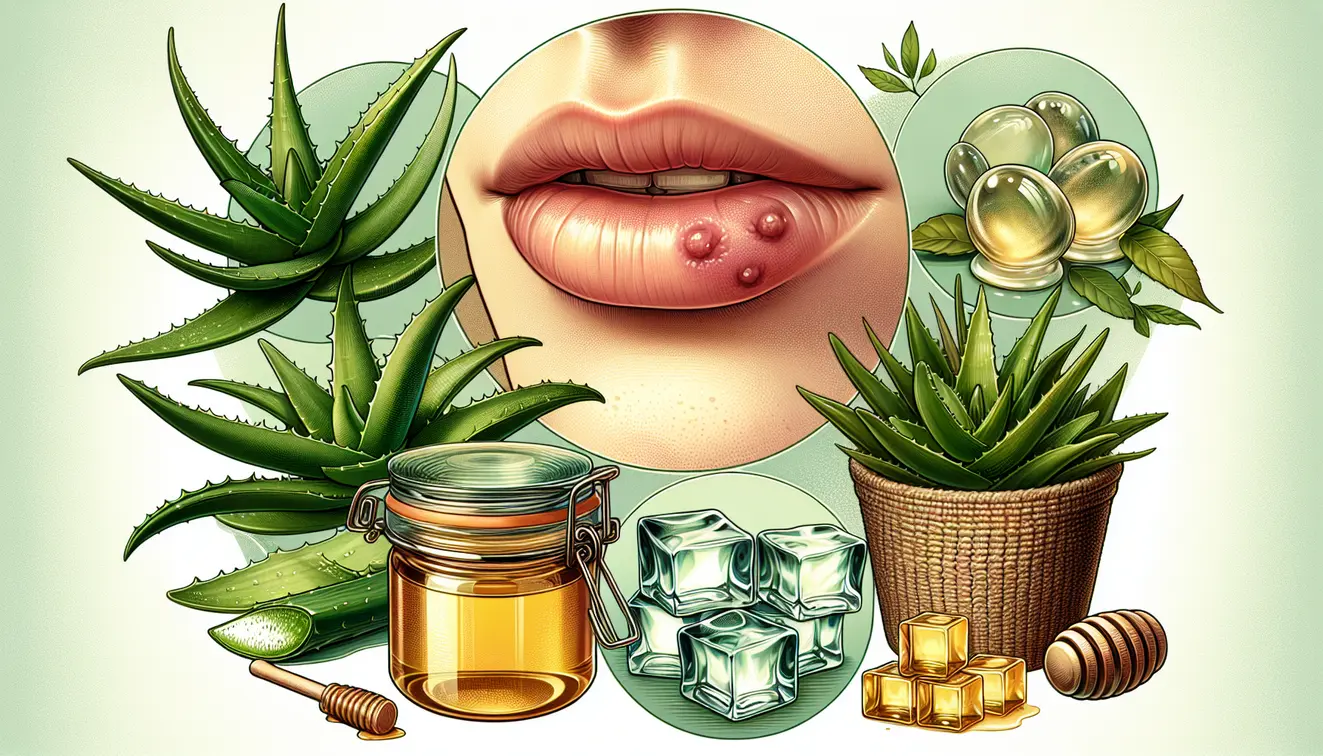Home Remedies For Cold Sores On Lips: Soothe Pain Naturally Today
Estimated reading time: 10 minutes
Key Takeaways
- Cold sores, caused by HSV-1, are painful blisters often on lips, affecting billions worldwide.
- Home remedies like ice, aloe vera, and honey can soothe pain and may speed healing naturally.
- Triggers such as stress, sun exposure, and fatigue can spark outbreaks; prevention is key.
- Hygiene practices, like clean hands and tools, prevent spreading the virus during treatment.
- Seek medical help for severe symptoms like sores near eyes or frequent recurrences.
Table of Contents
- Introduction to Cold Sores and Home Remedies
- What Are Cold Sores? Understanding the Basics
- Causes and Triggers of Cold Sores on Lips
- When to Seek Medical Help for Cold Sores
- Top 10 Science-Backed Home Remedies for Cold Sores on Lips
- Safety Tips and Best Practices for Applying Home Remedies
- How to Prevent Future Cold Sore Outbreaks
- Scientific Evidence Behind Home Remedies
- Frequently Asked Questions (FAQs) About Cold Sores and Home Remedies
- Additional Resources and Support for Managing Cold Sores
Introduction to Cold Sores and Home Remedies
Cold sores on the lips can be a real nuisance, causing discomfort and sometimes a bit of embarrassment. These small blisters, often triggered by the herpes simplex virus (HSV-1), affect over 3.7 billion people globally under age 50, according to WHO data. At WikiHomeRemedies, we understand how much you want a quick, safe way to ease that tingling pain and get back to feeling like yourself.
That’s why many turn to home remedies—natural, accessible solutions that can calm symptoms without breaking the bank. From soothing gels to everyday kitchen items, nature offers gentle ways to manage outbreaks right at home. Our mission is to guide you with trustworthy, science-backed advice, ensuring you find relief in 2025 and beyond.
We’re here to walk you through this journey, starting with a clear look at what cold sores are. Let’s dive into the basics so you can better understand how to tackle them.
What Are Cold Sores? Understanding the Basics
Cold sores are painful blisters that often show up on or around your lips, caused by the herpes simplex virus, type 1 (HSV-1). They start as a subtle itch or burn before forming fluid-filled bumps that eventually crust over. For many, seeing one pop up before a big event can feel frustrating, especially given how visible they are.
Here’s what you might notice when a cold sore strikes:
- A tingling or burning sensation before the sore appears.
- Small, fluid-filled blisters that can cluster together.
- Crusting or scabbing as the sore begins to heal over days.
This virus hides in your nerve cells, staying dormant until something wakes it up. According to the NIH, HSV-1 spreads through close contact like kissing or sharing utensils. Knowing this viral nature helps explain why they keep coming back. Let’s explore what sparks these outbreaks so you can stay one step ahead. For more detailed insights on managing herpes-related conditions, check out this guide herpes management.
Causes and Triggers of Cold Sores on Lips
Once HSV-1 enters your system, it’s there for life, lying low in nerve cells until a trigger brings it out. These triggers vary from person to person, but understanding them can help you reduce outbreaks. Studies from PubMed show factors like stress or UV exposure often play a role in reactivating the virus.
Common triggers include:
- High stress levels, like during a tough week at work.
- Fatigue from lack of sleep or overexertion.
- Sun exposure without lip protection, especially in summer.
- Hormonal shifts, such as during menstruation.
- Illness or a weakened immune system, like after a cold.
- Minor lip injuries, even from biting or irritation.
You can take small steps to dodge these, like wearing SPF lip balm during sunny days. Imagine feeling a sore coming on after a stressful deadline—avoiding such triggers could spare you the hassle. While prevention helps, knowing when to seek a doctor’s advice is just as vital for your safety.
When to Seek Medical Help for Cold Sores
Home remedies work wonders for mild cold sores, but sometimes you need more than nature’s touch. Severe cases or unusual symptoms mean it’s time to consult a healthcare provider. They can offer antiviral medications tailored to your needs, ensuring faster healing or managing frequent outbreaks.
Watch for these warning signs that signal medical attention is necessary:
- Sores spreading near your eyes, risking complications like ocular herpes.
- High fever or feeling unwell alongside an outbreak.
- Frequent recurrences, more than three or four times a year.
The Mayo Clinic warns against ignoring serious symptoms, as delays can worsen outcomes. For most, though, natural solutions handle the job just fine. Let’s move on to explore safe, effective remedies you can try at home to soothe those pesky lip sores.
Top 10 Science-Backed Home Remedies for Cold Sores on Lips
Ice or Cold Compress
Applying ice or a cold compress can ease the sting of a fresh cold sore. It helps calm swelling and numbs the area, offering quick comfort when that tingling starts. Dermatologists often note cold therapy as a simple way to tackle inflammation right at the outset.
Here’s how to use it:
- Wrap a few ice cubes in a clean cloth or use a cold pack.
- Press gently on the sore for 10-15 minutes, several times daily.
- Avoid direct ice contact to prevent skin irritation.
This method shines during the early burning stage. Keep a small pack handy for those sudden outbreaks.
Aloe Vera Gel
Aloe vera’s cooling touch soothes irritated skin and may speed up healing with its anti-inflammatory properties. Studies suggest it supports skin recovery, making it a go-to for minor wounds like cold sores. Opt for pure gel from a fresh plant or a trusted product.
Try this application:
- Scoop out fresh aloe gel or use a 100% pure store-bought version.
- Dab a small amount on the sore with a clean finger or cotton swab.
- Repeat 2-3 times a day until the sore improves.
It feels refreshing and keeps the area from drying out. Just ensure your source is free of added chemicals.
Tea Tree Oil (Diluted)
Tea tree oil carries antiviral potential, which might help fight the herpes virus behind cold sores. Research points to its antimicrobial strength, but it must be diluted to avoid burning your skin. Always prioritize safety with this potent extract.
Follow these steps:
- Mix 1 part tea tree oil with 10 parts carrier oil, like coconut or jojoba.
- Test a tiny amount on your inner wrist for sensitivity.
- Apply sparingly to the sore using a cotton swab, twice daily.
A little goes a long way, and patch testing prevents unwanted reactions. Used right, it’s a handy tool in your natural kit.
Lemon Balm Extract
Lemon balm, a member of the mint family, shows promise with its antiviral effects against HSV-1. Studies indicate it can cut healing time, often calming sores within days. You can find it as a cream or brew it as tea for dual benefits.
Here’s how to apply it:
- Use a lemon balm cream, applying a thin layer to the sore 2-4 times daily.
- Or, steep 1-2 teaspoons of dried lemon balm in hot water for tea; drink twice daily.
- Watch for skin reactions with topical use.
Its gentle action suits sensitive lips. Keep some on hand for early intervention when you feel that first tingle.
Lysine Supplements or Foods
Lysine, an amino acid, might lower outbreak frequency by balancing arginine levels, which HSV-1 feeds on. The NIH highlights studies showing reduced recurrence with consistent intake. You can get it from supplements or lysine-rich foods like dairy or fish.
Consider this approach:
- Take 1,000-3,000 mg of lysine supplements daily during an outbreak, per doctor’s advice.
- Add foods like yogurt, cheese, or salmon to your meals regularly.
- Avoid excess arginine from nuts or chocolate temporarily.
It’s a subtle shift that could keep sores at bay. Pair it with other remedies for broader support.
Honey (Manuka Preferred)
Honey, especially Manuka from New Zealand, has antibacterial traits that aid healing. Research praises its ability to protect wounds, and a dab on a cold sore can lock in moisture while fighting germs. Raw, unprocessed honey works best for this.
Use it like this:
- Apply a thin layer of raw Manuka honey to the sore with a clean finger.
- Leave it on for 15-20 minutes before gently wiping off, 2-3 times daily.
- Wash hands after to avoid spreading the virus.
It’s a sweet, simple fix straight from nature. Keep a jar in your pantry for emergencies.
Coconut Oil
Coconut oil moisturizes cracked sores and may carry antiviral benefits thanks to lauric acid. While evidence is mostly from small studies or user reports, its hydrating effect prevents painful splitting. Always choose pure, unrefined oil for the best outcome.
Here’s the method:
- Dab a small amount of virgin coconut oil on the sore using a clean swab.
- Reapply 3-4 times daily to keep the area soft.
- Avoid overuse if your skin feels greasy or clogged.
It’s a staple you likely already have. This remedy doubles as a protective barrier during healing.
Echinacea Tea or Extract
Echinacea boosts your immune response, potentially helping your body fight HSV-1 flare-ups. Research supports its role in strengthening defenses, whether sipped as tea or used topically. It’s a herbal ally for overall wellness during an outbreak.
Try this routine:
- Brew echinacea tea with 1 teaspoon of dried herb per cup; drink 1-2 cups daily.
- For topical use, cool the tea, soak a cloth, and apply for 10 minutes.
- Check with a doctor if you’re on other medications.
Supporting immunity could lessen outbreak severity. It’s a warm, comforting option to explore.
Apple Cider Vinegar (Diluted)
Apple cider vinegar might dry out sores, speeding scabbing, though evidence is largely from personal accounts. Its acidity demands careful handling to avoid burns. Dilution is non-negotiable for safe use on delicate lip skin.
Follow this guide:
- Mix 1 part apple cider vinegar with 4 parts water.
- Dab the solution on the sore using a cotton swab, once daily.
- Rinse off after 5 minutes and moisturize to prevent dryness.
Proceed with caution, as irritation can occur. Stop if you feel any stinging beyond a mild tingle.
Garlic Paste
Garlic’s allicin compound offers antiviral properties, possibly hampering HSV-1 growth, as small studies suggest. Its raw form works best for a direct impact on sores. This kitchen staple doubles as a natural fighter when used thoughtfully.
Prepare and apply like this:
- Crush 1 small garlic clove into a paste with a bit of water.
- Apply a tiny amount to the sore, leaving it on for 5-10 minutes.
- Rinse gently and wash hands thoroughly after use.
Its strong nature means short exposure is key. Garlic can be a surprisingly effective addition to your remedy lineup.
Safety Tips and Best Practices for Applying Home Remedies
Using home remedies feels empowering, but hygiene remains your shield against worsening sores. Clean hands and tools stop the virus from spreading to other areas or people. A little care ensures these natural solutions work without hiccups.
Keep these practices in mind:
- Wash hands before and after touching the sore to limit germ spread.
- Use fresh cotton swabs or tissues for each application, discarding them after.
- Perform a patch test on your arm for topical items like oils or extracts.
- Apply remedies 2-3 times daily, but stop after 7 days if there’s no change.
- Never pick at sores, as this delays healing and risks infection.
- Avoid sharing personal items like towels or lip balm during an outbreak.
The Mayo Clinic stresses cleanliness to avoid complications. Think of touching a sore with unwashed hands—bacteria could turn a small issue into a bigger one. These habits not only protect you now but also help prevent future flare-ups.
How to Prevent Future Cold Sore Outbreaks
Stopping cold sores before they start is just as crucial as treating them. Building your body’s resilience and dodging known triggers can cut down on those unwelcome blisters. Lifestyle tweaks offer a strong line of defense for long-term ease.
Try weaving these habits into your routine:
- Manage stress with breathing exercises or a quick walk daily.
- Prioritize 7-8 hours of sleep to keep fatigue from weakening immunity.
- Eat immune-boosting foods like citrus fruits or leafy greens.
- Shield lips with SPF 15 or higher balm during sun exposure.
- Wash hands often and steer clear of touching your face unnecessarily.
Research from NIH ties stress reduction to fewer outbreaks, showing mind-body balance matters. A product like a medicated SPF lip stick can be a practical guard against UV-triggered sores. These steps echo earlier advice on triggers, forming a full-circle strategy to keep sores away.
Scientific Evidence Behind Home Remedies
Natural remedies aren’t just folklore—many carry weight from research or historical use. While they don’t cure HSV-1, they often ease symptoms or shorten healing time, offering real relief. Transparency matters, so let’s look at what science says about these solutions.
Key findings include:
- Lysine studies from NIH suggest 1,000-3,000 mg daily may lower outbreak rates.
- Lemon balm, per PubMed, cuts healing by 2-3 days in some topical trials.
- Tea tree oil shows antimicrobial promise in lab settings, though human results vary.
- Honey, particularly Manuka, aids wound recovery, as noted in clinical reviews.
Dermatologists often acknowledge these options for mild cases but remind us results differ person to person. Natural methods complement, not replace, medical care for severe outbreaks. This grounding in evidence ties directly to the remedies we’ve shared, answering lingering questions you might have.
Frequently Asked Questions (FAQs) About Cold Sores and Home Remedies
Can home remedies completely cure cold sores?
No, home remedies can’t eradicate the HSV-1 virus from your body. They focus on managing pain, reducing swelling, or speeding healing. For a full antiviral approach, a doctor’s prescription might be needed, as WebMD explains.
What’s the difference between a cold sore and a canker sore?
Cold sores stem from HSV-1 and appear outside the mouth, usually on lips. Canker sores, however, form inside the mouth and aren’t viral. Knowing this helps you pick the right treatment path. For more on canker sores and their remedies, see this resource canker sores remedies.
Which remedies work best for early-stage versus late-stage sores?
In the early tingling phase, ice or lemon balm can halt progression. Later, when scabbing starts, honey or coconut oil keeps the area moist and protected. Tailoring your choice to the stage boosts effectiveness. For additional tips on early intervention, explore this guide cold sore remedies.
How do natural remedies compare to over-the-counter creams?
Natural options like aloe or tea tree oil soothe with fewer additives, often at lower cost. Over-the-counter creams, such as those with acyclovir, target the virus more directly but may irritate some. Both have a place, depending on your outbreak’s intensity.
Additional Resources and Support for Managing Cold Sores
Navigating cold sores gets easier with the right tools and knowledge at your fingertips. WikiHomeRemedies offers related guides on lip care and immune health to deepen your natural wellness journey. Check out our articles on boosting immunity or protecting skin for more insights. For specific guidance on fever blisters, which are closely related to cold sores, take a look at this helpful post fever blister remedies.
For broader learning, trusted sources like WHO or NIH provide detailed HSV-1 information. These platforms expand on viral behavior and treatment options beyond home care. You’re never alone in seeking answers or solutions.
We’d love to hear from you—share your experiences or favorite remedies in the comments. WikiHomeRemedies stands as your partner, committed to safe, sustainable paths to well-being. Let us guide you toward healing with nature’s gentle strength. For further reading on managing the herpes virus, refer to this comprehensive resource herpes virus remedies.










